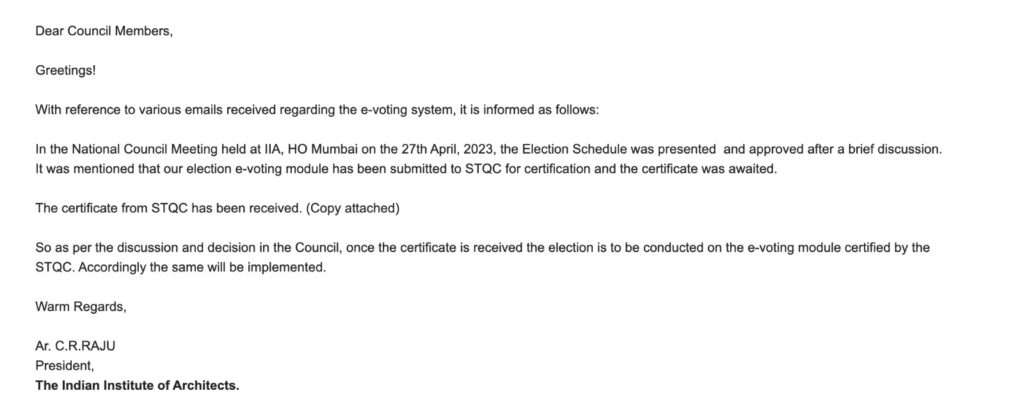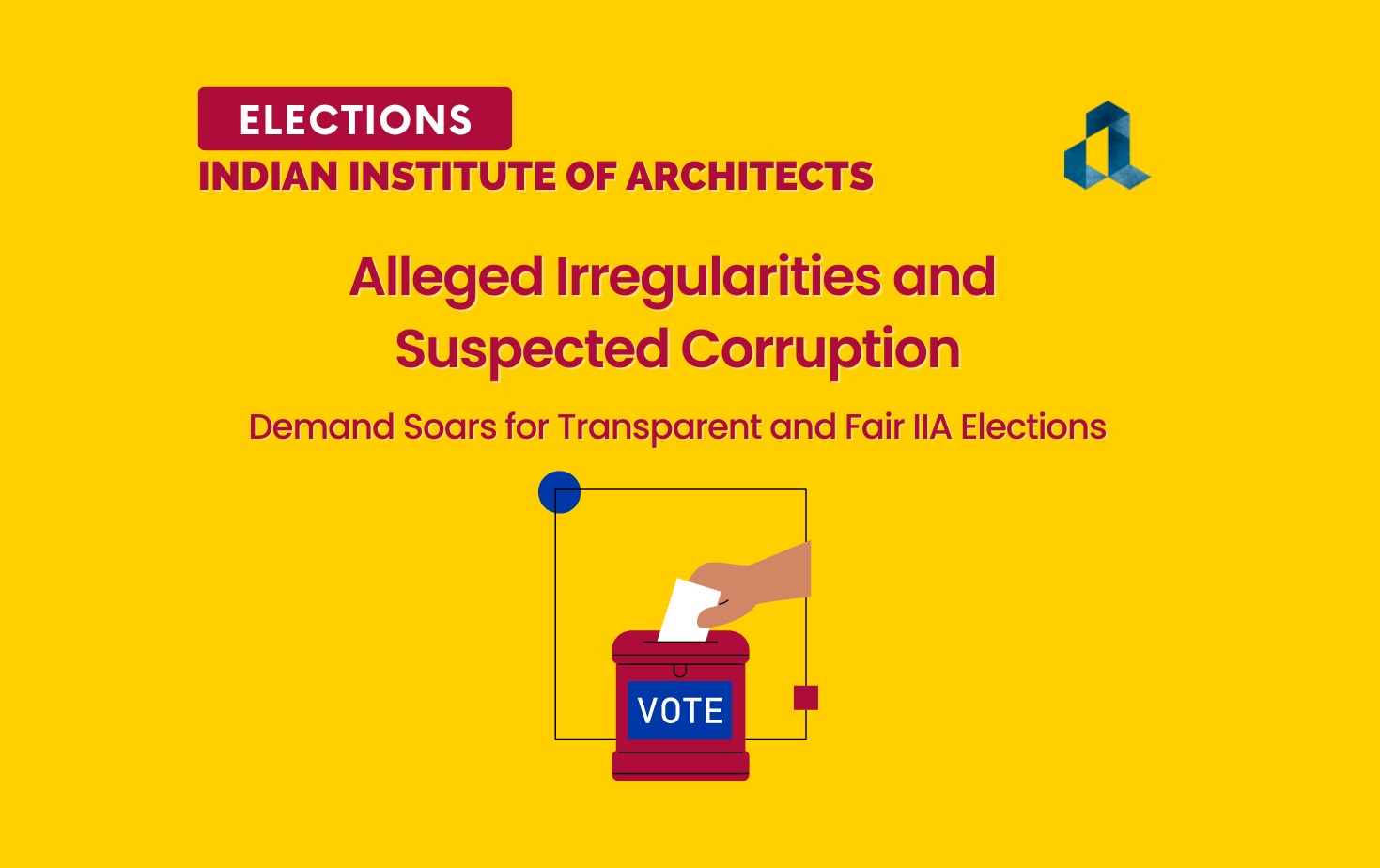Amidst concerns regarding suspected corruption and alleged irregularities, the country’s oldest National Body of Architects, the Indian Institute of Architects, is gearing up for its next election. Scheduled for towards the end of June 2023 (around June 27), the upcoming election has re-ignited apprehension regarding the process amongst its members.
Established in 1917, The Indian Institute of Architects (IIA) is a National body of Architects in the country with about 27000 members. The IIA plays a major role in promoting the profession’s interests and is helmed by a committee of elected members who lead for a two-year tenure. This year, four candidates are expected to contest for the organization’s presidential post.
With the impending elections a few weeks away, demands regarding transparently conducting the elections have escalated. Citing the previous election, several members have pointed out the loopholes in the election process. For the previous election, held in 2020, claims were made by several members that the software used for the hybrid system of voting, which gave the members a choice to choose between ballot papers and e-voting, involved a bug which allowed anyone to use a registered IIA member’s account and vote- this hacking process was also explained on a YouTube channel, “Professional FIRST”.
The 2020 election continues to be the subject of several petitions before Delhi’s High Court. According to an email sent by IIA member Col Anuj Srivastav (retd.) to the incumbent President and Scrutineers, the High Court issued notice and made the previous elections “subject to the outcome” of the petitions. Further, a High Court order, dated May 18, 2023, categorically directed that any subsequent elections, including the current election, were to remain subject to the outcome of the petition.
To proceed with a fair election process, a section of IIA members, including several contesting candidates, have demanded the organization conduct elections through an independent third party- the National Securities Depository Limited (NSDL), citing its repute in conducting elections for government and renowned private organizations. According to several IIA members, who were informed that a representative reached out to NSDL for the same, the institute mentioned a lack of funds and NSDL’s refusal to proceed on short notice as the reasons for not taking this ahead.


Since Ministry of Corporate Affairs (MCA) has authorised NSDL for setting up an electronic platform to facilitate shareholders to cast their votes. An agency who we also can rely for neutral conduction of election. So it would be best in interest for having a fair election through NSDL and faith of members can be restore in the system.
An email sent by a member to the President and Scrutineers
Architects, including Anuj in his email, have called out these reasons presented by the institute and mentioned that NSDL was willing to proceed on short notice, provided confirmation is given in the coming few days. Further, the quote shared by NSDL was found to be reasonable and comparable with the current budget. Some members also came forward with their willingness to fund additional expenses.
This demand is further backed by a National Council Member Candidate in their email to the President and Scrutineers, wherein they have voiced their concern regarding the allegations of impropriety in the conduct of elections with an opaque and unverifiable system that was employed last time and is proposed to be used again in the coming election.
I see no reason why we should not use the most reputed and recognised agency for these important elections, unless there is a malafide intent in promoting a particular private, unknown agency.
From the aforementioned email
With growing concerns regarding IIA’s seemingly unwavering stance, the credibility of the election process and the current committee is under scrutiny. Members have voiced their disappointment and are repeatedly encouraging the organization to prioritize transparent elections- a point of concern since the last three elections, as per an email by Ar Punit Sethi to IIA President Ar C.R. Raju.
I am disappointed that you have expressed inability to consider NSDL as the agency, citing lack of mandate from the IIA Council. I wish to once again remind you that in the 12th Council Meeting the Council had authorised you to take an appropriate action in considering a third party platform option for conducting the E-Voting. You not only have the mandate to do so, you as the President have the authority to take all actions for the benefit of the Institute. Election is a very sensitive process and requires transparency on all quarters. It is the right of every candidate and every voter that the election be conducted in a free and fair manner. The last 3 elections that have been conducted online have drawn protests from various quarters on account of lack of transparency, compromised software, etc. These are reasons good enough for you to consider a neutral and reliable third party platform for conducting the E-Voting.
Ar Punit Sethi in his email to IIA President, C.R. Raju
In response to the members’ demand to involve a third party, IIA President C.R. Raju pointed out the certificate received from the STQC (Standardisation Testing and Quality Certification Directorate), which bound the organization to conduct the e-voting in the process certified by the STQC.

However, the members claim that the STQC only certifies the security of the website and not any application, in this case, the voting software, that may run on the website.
If I am not wrong, the STQC is merely a statement that the agency can carry out e-voting as per the MCA guidelines. It doesn’t certify that the system cannot be compromised.
An IIA Member during a discussion on the organization’s response
The election processes of both IIA and COA (Council of Architecture)- the two National Bodies of Architects in India, have constantly been topics for suspicion and controversies. The lack of a transparent and open process has contributed to scepticism regarding the institute’s relevance and reliability.
I want open details of the last COA IIA REP ELECTION. I am one of the persons affected by it. I want all of them to step aside from their current position and conduct the COA IIA rep election again and call the elections illegal and immoral.
An IIA Member
As a section of IIA members continues to oppose the organization’s stance in response to their growing concerns regarding the integrity of the election process, the involvement of a neutral third party will definitely contribute to a transparent election. For an organization struggling with being represented by a minor fraction of registered architects (only 27,000 of the nearly 1.5 lakh registered architects are members of IIA) and considered invisible by most of the non-members, rising doubts within its own member community and internal division might bring along far-reaching consequences. This might undermine the original purpose of IIA, which strives to unite architects.
As conflict persists, we conclude this article by quoting IIA itself,
…(IIA) plays a major role in promoting the profession of architecture by organising and uniting the Architects of India to promote aesthetic, scientific and practical efficiency of the profession both in Practice and in Education.








5 Responses
Because of lack of trust more than 80% of the registered Architects remain away from membership of IIA. Every time during the elections lot of noise is generated and thereafter all is well till next election.
You said it
I agree.
Sorry to say, IIA does not exhibit any level of confidence in young professionals. Several of my staff always respond “What have they done which is worthwhile???”
The alarmingly low percentage of registered architects in the IIA raises a critical question: Why do architects feel disconnected from this wonderful organization? This striving for change can begin at the state level, where each newly elected chairman can play a pivotal role. They should be tasked with reporting two key points: Firstly, what is the ratio of IIA members to registered architects in their respective state? This data will provide crucial insights into the level of association participants. Secondly, the elected chairman should address the underlying issues if the state does not even have 30% IIA members compared to the number of registered architects. A systematic survey can be conducted to identify the reasons behind this disparity and formulate effective strategies to bridge the gap. By focusing on the state level and addressing these specific concerns, we can foster a more inclusive and engaged architectural community within the IIA.
Furthermore, the article rightly highlights growing concerns regarding the integrity of the election process. However, it is crucial to delve deeper and ask ourselves: Why would someone want to undermine the system? What are the underlying motivations or frustrations that lead individuals to challenge the integrity of the election process? By exploring these thought-provoking questions, we can gain a deeper understanding of the dynamics within our architectural community and work towards building a stronger and more cohesive association.
As this article is circulating within various architectural WhatsApp groups, let us engage in a constructive dialogue to address these concerns and collectively strive for a more inclusive, transparent, and accountable IIA organisation. Together, we can shape a brighter future for our profession.
The alarmingly low percentage of registered architects in the IIA raises a critical question: Why do architects feel disconnected from this wonderful organization? This striving for change can begin at the state level, where each newly elected chairperson can play a pivotal role. We should task them with reporting two key points: first, what is the ratio of IIA members to registered architects in their respective state? This data will provide crucial insights into the level of association participation. Second, the elected chairperson should address the underlying issues if the state does not even have 30% IIA members compared to the number of registered architects. A systematic survey can be conducted to identify the reasons behind this disparity and plan effective strategies to bridge the gap. By focusing on the state level and addressing these specific concerns, we can foster a more inclusive and engaged architectural community within the IIA.
Furthermore, the article rightly highlights growing concerns regarding the integrity of the election process.
However, it is crucial to delve deeper and ask ourselves: Why would someone want to undermine the system? What are the underlying motivations or frustrations that lead individuals to challenge the integrity of the election process? By exploring these thought-provoking questions, we can gain a deeper understanding of the dynamics within our architectural community and work towards building a stronger and more cohesive association.